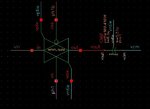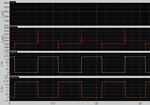urian
Full Member level 3
HI
I have simulated a transmission gate,but the output plot as attactment contains some strange waveform.When the clock signal jumping high or low,the output will suddenly jump high and low,then return to the final value instantly.What cause these occur?Does it because the transmission will sorb electron as it begin to conduct and release electron when it begin to cutoff? Or because the clock feedthrough? Why the polarity looks like this?
Thanks for help
urian
I have simulated a transmission gate,but the output plot as attactment contains some strange waveform.When the clock signal jumping high or low,the output will suddenly jump high and low,then return to the final value instantly.What cause these occur?Does it because the transmission will sorb electron as it begin to conduct and release electron when it begin to cutoff? Or because the clock feedthrough? Why the polarity looks like this?
Thanks for help
urian

